How to upgrade your RAM
Whether you're playing a game or just browsing the Web, doing so on a machine with the bare minimum amount of RAM won't provide for a pleasant experience.
Many gamers have very capable computers according to Valve's hardware survey. Not everyone has 3GHz CPUs paired with GeForce 7800 GTXs, but about 90 percent of all the computers surveyed have an Athlon XP, a Pentium 4, or better CPU. On the video card front, almost 65 percent had a video card made in the last three years.
In light of these facts, the information we came across regarding RAM was rather startling. Almost 10 percent of all systems surveyed have less than 256MB of RAM, and another 40 percent have less than 512MB of RAM. Combine these low memory numbers with the fact that around 97 percent of people in the survey run some variant of Windows XP or Windows 2000, and you have the perfect recipe for sluggish performance. Even though the system requirements for Windows XP aren't huge, a machine with the bare minimum amount of RAM won't provide for a pleasant experience, whether you're playing a game or just browsing the Web. Windows XP, and the associated software bloat that accumulates over time, will chew through 128MB, and even 512MB, of RAM very easily.
The cost to upgrade your RAM subsystem actually amounts to a relatively trivial amount of cash if you want to get up to 512MB. For $50, you can get a complete 512MB memory kit. If you already have a 256MB stick, adding another module only costs $25, almost half the cost of a regular game. Upgrading your RAM will improve the feel and the overall performance of your machine by incalculable amounts.
We run our usual test beds with 1GB of RAM. We only drop down to 512MB or lower when we want to see how games perform with less than optimal amounts of memory. We don’t even factor 128MB of RAM into our testing. Our testing has shown that playing most modern games with less than 512MB of RAM proves to be very difficult.
The difference between having 1GB versus 512MB of RAM in a game like Doom 3 is noticeable, but still very playable Note that Doom 3 requires a bare minimum of 512MB of RAM--it still runs with 256MB and 128MB of RAM. But the sluggish system performance, the way the game seems to freeze a little each time you turn a corner, might be scarier than the game itself. The results shown never stabilized, and the game was far from playable with this little RAM.
Doom 3 is known to be fairly hardware intensive, but even non-FPS games benefit from having more memory. The popular MMORPG World of Warcraft is notorious for its memory needs. If you want to have fun in Azeroth, you better have 1GB of memory.
Test System:
Graphics Cards:
Graphics Drivers: Nvidia ForceWare 77.77.
Building up the nerve to open up your computer to perform upgrades can be difficult, but with the proper knowledge, it can be relatively painless. Installing RAM is actually one of the easiest upgrades you can do. In our opinion, it's harder to choose what RAM you need than the install itself.
Choosing what kind of RAM you need largely depends on the kind of computer you have. Most computer systems only accept one kind of RAM, and for the most part, newer computers will fall into one of two categories, either DDR or DDR2 SDRAM. You can find multiple versions of DDR SDRAM on the market. You might see one called a SO DIMM, which has 200 pins, or connections, on the bottom. This kind of RAM is largely used in laptops. Desktop DDR memory generally comes with 184 pins and is considerably larger in physical size. DDR2 SDRAM looks quite similar to DDR SDRAM, but it has 240 pins and a notch that is closer to the middle.
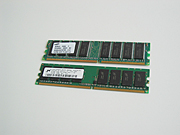 | 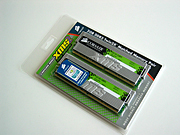 |
If you don't know what you need, you can easily contact the manufacturer of your computer to find out, or just use a memory detection program like the Crucial Memory Advisor Tool. All you have to do is input what kind of system you own, and it will tell you what kind of memory you need. Crucial even made the Crucial System Scanner recently, so even if you don't know what kind of system you own, the program will do the legwork for you.
You've likely heard the terms DDR400, PC3200, and others in reference to DDR and DDR2 RAM. Numbers prefaced by DDR generally stand for the speed. So in the case of DDR400, the RAM is capable of operating effectively at 400MHz. DDR itself stands for dual data rate, so the 400MHz number is actually doubled from an original 200MHz specification. PC3200, on the other hand, refers to RAM bandwidth, and in this case it means the RAM can process up to 3.2GB/s. These two specifications are actually used to describe the same product. RAM with a higher speed, such as DDR500, will have a correspondingly higher bandwidth rating of PC4000. In general, you should buy the spec that matches your computer, as higher speed ratings won't necessarily increase performance. As a side note, for SDRAM (non-DDR), PC133 actually refers to the speed, or 133MHz operation.
If you're looking to squeeze every drop of performance out of your system, or you want to overclock, you might be interested in high-end products designed for power users and gaming enthusiasts. Premium memory usually has above spec speed ratings that also come with lower timings for specs like CAS latency, which tend to give your computer a slight boost in performance.
However, you don't have to spend a lot of money on premium memory since just having more RAM in your system will give you better performance. We highly recommend avoiding extremely cheap memory. With RAM, you get what you pay for. Low-quality RAM can cause all sorts of problems that lead to crashes and freezes.
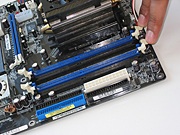 | 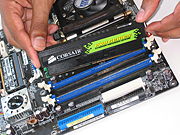 |
Many motherboards can use matched memory modules for dual-channel operation, so if you plan on upgrading a computer that supports dual-channel memory make sure to get two sticks of RAM from the same manufacturer to ensure stability. Dual-channel systems tend to get finicky if you try to mix and match modules. So if you plan to add to your existing memory rather than replace it, make sure that you get exactly the same make and model. Many companies sell dual-channel memory packs, which come with two sticks of memory that are pretty much guaranteed to work with each other.
Once you've purchased your RAM, it's time to install it. So, power down your computer, unplug it, and then open the case. You can usually find a few screws that will release the side panel, or a handle that you can pull. Make sure to ground yourself by touching an unpainted metal surface on your computer or the metal surface of the system power supply to discharge any static electricity before you handle the memory or start working inside the case.
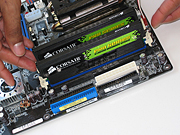
Locate the RAM slots on your motherboard (depending on how many slots you have, you might have to take out your old memory to make room). If you're removing old memory, simply push away the retention tabs on both sides of the RAM outward and gently remove the module.
When installing new memory, make sure the connector is lined up correctly with the memory socket before applying any pressure. Look at the slot and find the notch in the middle. Line your memory up with the notch (you may have to turn the module around), and then slide the module in between the retention tabs and push down firmly to lock the module in place. The downward pressure should force the retention tabs into place to ensure that the stick doesn't fall out. If you have a dual-channel setup, make sure to put RAM in the appropriately colored slot (in our case, we used both blue slots). Now close up your computer and boot up. Most computers will automatically recognize the extra memory without any further configuration.
Got a news tip or want to contact us directly? Email news@gamespot.com
Join the conversation